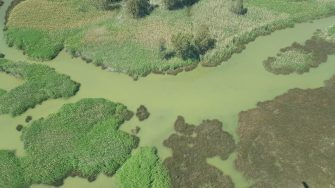
Date: Tuesday, October 29, 2019
Project: Eastern Australian Waterbird Survey
Observers: Richard Kingsford & Paul Wainright
Pilot: Tim Dugan
Today and tomorrow’s run down the River Murray is always a treat. We followed the river from Albury all the way to Mildura today and then tomorrow the rest of the way right down to the mouth of the Murray. You can really appreciate this great river and its many issues. On the way, we flew from Sydney to start in Albury, past Pejar Dam and its nearby wind farm, which we surveyed last week.
Our first survey run started on Lake Mulwala or Yarrawonga Weir which holds back water so it can be diverted north along Mulwala canal to irrigation areas.
Yarrawonga Weir holds back a big body of water, with lots of dead trees which have been waterlogged from too much water and never drying out. This, like a lot of dams, is not favoured waterbird habitat, certainly not the ducks. It had its usual small numbers of a few swans, pelicans and cormorants. The water is probably too deep for many other waterbirds.
As well as the large wetlands that we survey each year, we also survey five small stretches of the River Murray, as samples of the river habitat. There are rarely any waterbirds along these stretches of the river, although a few wood duck flocks are sometimes around. Today was no different.
Next, we surveyed the Barmah-Millewa Forest – such a huge red gum forest. When it is full, we run 10 north to south surveys across it. Today, the river was confined to its channel, until we got to the downstream swamps which were on either side of the river. Here the reedbeds were all flooded.
There weren’t many waterbirds, apart from a few swans, white ibis and cormorants. There was a small group of about 30 nesting white ibis on one of the swamps. It certainly wasn’t bustling with waterbirds, despite all the water around.
Once we had worked our way around the swamps, we surveyed Moira Lake. Again I was surprised at how few ducks there were here, just a few black duck and no more than 50 grey teal. There were also small numbers of pelicans and cormorants and a musk duck. Always great to see these birds. I don’t see as many musk duck as I used to.
Then on to Barmah Lake and its shallow water areas to the east. Here, there were flocks of 10-20 egrets, Pacific herons, straw-necked ibis and yellow-billed spoonbills. But not many ducks. This seems to be the pattern this year. Where there is water, we expected lots more waterbirds but they are few and far between.
Then on to Koondrook-Perricoota Forest. Here the water was just confined to the main channel and all we saw was the odd cormorant on the main stem of the river.
We then flew past the river town of Barham, right on the banks of this winding river.
Then onto the next major wetland – the Hattah-Kulkyne Lakes, another listed wetland of international importance under the Ramsar Convention. Here you could see the value of environmental flows which had flooded Lake Kramen, one of the closer lakes to the river.
There were a few waterbirds here but not many. Just a handful of grey teal, black duck, hardhead and cormorants. The dark colour of the water was probably indicative of recent flooding with the tannins leaching out into the water. It will probably take a little longer for the food webs to get established and the lakes become really productive. Further to the west the opposite was happening with Lake Hattah drying back.
These shallow lakes can sometimes have large number of waterbirds, because this is when there food is most available. But apart from a few flocks of grey teal, avocets, pied stilt and yellow-billed spoonbills, there were not huge numbers of waterbirds here. There were a couple of small sized pelican flocks.
Just east of Lake Hattah, the smaller lakes had dried almost completely and were littered with dead carp. This is not an unusual event and in the best of all possible management scenarios, drying up these lakes occasionally is important for natural cycling processes but with the added advantage that it traps the carp which die in their thousands. Some of these fish were large. The whistling kites had plenty of food.
We finished up in Mildura.
